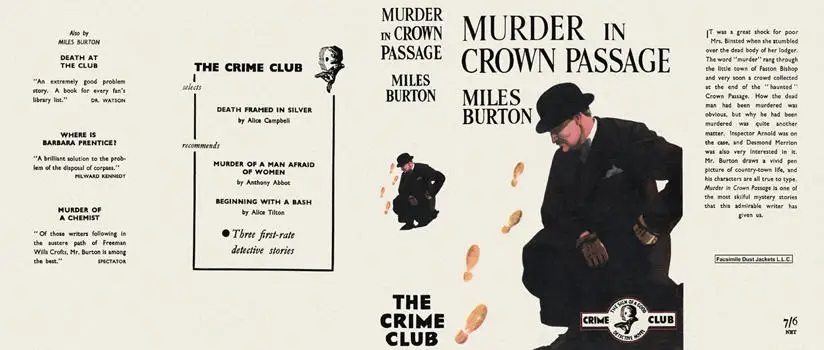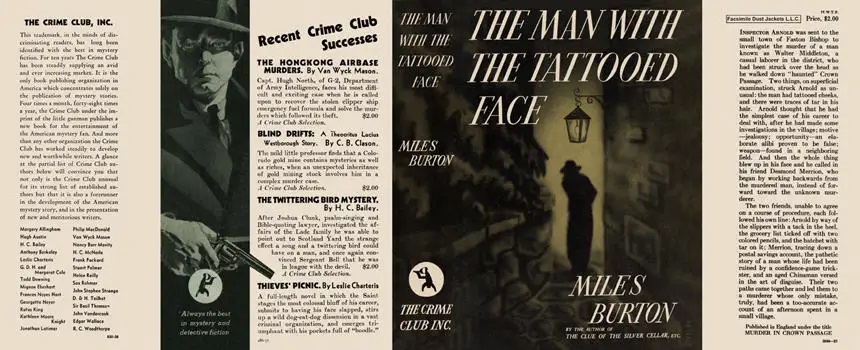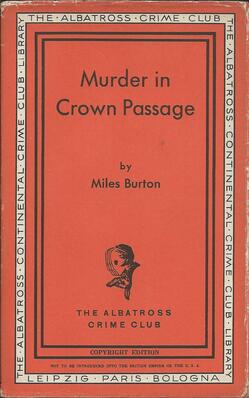(US title – ‘The Man With The Tattooed Face’)

After a short hiatus due to some overseas work commitments, today I am returning to my chronological review of every mystery written by Cecil John Charles Street under his ‘Miles Burton’ pseudonym.
During the latter-half of the 1930’s, what is now referred to as Golden Age detective fiction was still going strong, with sales healthy and many of its most popular and enduring authors still producing high-quality work. However, things would change swiftly over the next decade, with the loss of several greats of the genre. Dorothy L. Sayers and Anthony Berkeley were among the authors who decided not to continue, whilst R. Austin Freeman, S. S. Van Dine and Carolyn Wells were among those who passed away. However, other writers ploughed on, and Street was one who continued to produce work which changed little from what had gone before, except for a diminishing of the role of the private super-sleuth for a more police-procedural approach in his ‘John Rhode’ books, with Dr. Lancelot Priestley becoming less and less active in investigating crime and sometimes appearing only briefly in order to aid the police. This mystery, from 1937, is still firmly in the classic Golden Age style, as the Burton books mostly remained, with minimal alteration for the next two decades.
It was a great shock for poor Mrs. Binsted when she stumbled over the dead body of her lodger. The word ‘murder’ rang through the little town of Faston Bishop and very soon a crowd collected at the end of the ‘haunted’ Crown Passage. How the dead man had been murdered was obvious, but why he had been murdered was another matter. Inspector Arnold was on the case, and Desmond Merrion was also very interested in it. Mr Burton draws a vivid pen picture of country-town life, and his characters are all true to type. Murder in Crown Passage is one of the most skilful mystery stories that this admirable writer has given us.
Blurb of 1st UK edition
Here, series-regular Inspector Arnold of the Criminal Investigation Department of Scotland Yard is summoned to the rural community of Faston Bishop, another of Burton’s archetypal English country villages, an environment he always portrays with skill. There, Arnold’s aid is invoked by the local police in their investigation into the bludgeoning to death of a man in the Crown Passage of the title, a quiet lane popularly believed by the superstitious local-folk to be haunted after dark. The victim was a relative newcomer to the district known as Walter Middleton, who had been employed in various manual jobs, and it quickly becomes apparent that there is a secret in his past, as well as his present. How can he have been living beyond his meagre means? Why is his face disfigured with recent tattoo marks? What are his relations to the attractive married woman who runs the local general store? These and many other questions perplex Arnold as he delves into local rumour and jealousies.

Naturally, Arnold is soon seeking aid from his regular associate, the suave ex-naval intelligence officer Desmond Merrion, who begins to help the Scotland Yard man disentangle the confused threads of the evidence that abounds. Once the duo are working together sound detection from physical clues on the ground, detailed analysis of numerous witness statements and a thorough examination of the timeline of the crime begin to bring the detectives closer to the solution. However, they disagree on the appropriate course to solve the mystery. Arnold is convinced that the answer to the riddle is to be found locally and concentrates on the couple who run the general store, building a case against the husband, who he suspects is motivated by jealousy of the dead man. Merrion has other ideas, believing that the roots of the crime are to be found many miles away, among the wharves and docks of the Port of London. This rivalry allows for some nicely fractious exchanges between the two investigators with some waspish exchanges between the pair. But it is once again one of Merrion’s ‘leaps of imagination’ – as Arnold is disposed to describe them – and the aid of a Policeman with a remarkable memory of city criminals that enables the investigators to finally develop a theory of the crime that explains everything satisfactorily.

A complex tale from the height of Golden Age, some may feel that this mystery does not quite reach the sustained level of quality of Burton’s very best, since the solution does rely on the investigators being given vital information by an outside source in the latter chapters, but there is still much here to admire. The local characters are portrayed as more than cardboard cut-outs, with realistic emotions and histories, and the impact of the crime on their lives is not overlooked. This is particularly true of the Crudwell’s, who own the local store and whose marital problems are laid bare, to become the focus of gossip and speculation amongst their neighbours. One aspect which is particularly gratifying to this reviewer is the inclusion of a good quality map of the locality – something which is unfortunately missing from many of Street’s stories where such an addition would prove very useful. This, like all Burton’s from the period, is as desirable as it is elusive, and is likely to remain so until some publisher undertakes a comprehensive reprinting campaign of this series – and in so doing accomplishes an inestimable service for all devotees of the realist school of Golden Age detective fiction.
——–++++++++——–
7.5/10
Desmond Merrion / Inspector Arnold #16
Preceded by Death At The Club
Succeeded by Death At Low Tide
——–++++++++——–
Edition Reviewed
Albatross Paperback Edition, 1939 (my collection)
——–++++++++——–
Collector’s Notes
No record of any modern reprint, ebook or audiobook has been traced by the reviewer
——–++++++++——–
First Edition Details
UK
Originally published by Collins Crime Club 1937
Orange Cloth Boards, pp 320, 8vo
Title and Author stamped in black on spine. ‘The Crime Club’ stamped in black at bottom.
Front Board plain.
Dustwrapper priced at 7/6 net on front flap.
US
Originally published as The Man With The Tattooed Face by The Crime Club inc., Doubleday & Doran, New York 1937
Black Cloth Boards, pp 278, 8vo
Title and Author stamped in yellow on spine. ‘The Crime Club Inc.’ stamped in yellow at bottom.
Front Board plain.
Dustwrapper priced at $2 on front flap.
——–++++++++——–
R E Faust
——–++++++++——–
Please leave any comments, corrections or suggestions below.
——–++++++++——–
[…] by Murder In Crown Passage (US title – The Man With The Tattooed […]
LikeLike
[…] Preceded by Murder In Crown Passage […]
LikeLike